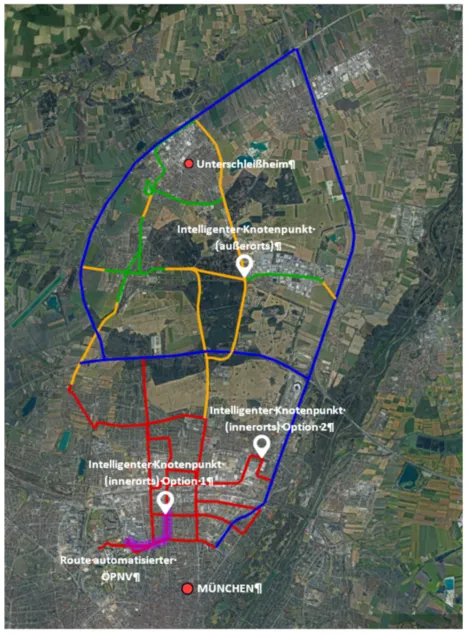TEMPUS – Testbed Munich – Pilot test of urban automated road traffic
Project Description
The following topics are dealt with in the TEMPUS project:
- Extensive and realistic testing (field tests) of automated and networked vehicles (AVF) of the IV (including BMW) but also of the public transport (SWM / MVG, Ebusco) in real traffic in the Munich metropolitan area.
- Definition and construction of a cross-regional authority (LHM, Landesbaudirektion (LBD) of the Free State of Bavaria) test field for automated and networked driving in the north of Munich In coordination with the automotive industry (BMW and Ebusco) and infrastructure suppliers (Siemens) as well as transfer to a cross-developer reference architecture.
- Creation of a database for AVF through high-resolution road traffic (HD maps) and making it available to the relevant actors.
- Targeted field tests with AVF from BMW, TUM and Ebusco buses from MVG in a communicating group (V2V) to gain new insights into the driving behavior and traffic behavior of all road users (including pedestrians and cyclists).
- Development of safety applications (e.g. turning assistant), relevant communication infrastructures (e.g. road-side units at traffic lights) as well as new simulation models and tools for the interaction of autonomous vehicles with non-motorized road users (e.g. cyclists and pedestrians).
- Investigation of the integration of personal mobility and logistics through an overall concept for a parcel ridepooling service (simultaneous transport of people and goods in one vehicle)
- Participation processes to determine the needs of other groups of actors (e.g. regional authorities) and those affected (e.g. citizens).
- Investigation of the effects of AVF on Vulnerable Road Users (VRU) such as cyclists or pedestrians.
- Extrapolation of the knowledge gained in the field tests to evaluate the traffic effects of AVF up to the complete market penetration of AVF on the basis of microscopic traffic flow simulation.
- Further development of existing modeling and traffic control approaches and simulative testing of new control methods such as managed lanes and automated lane-free traffic with different vehicle sizes.
- Creation and publication of a practice-oriented guideline for German municipalities and authorities with the knowledge of the expandability and the growth process of application fields for AVF across municipal boundaries on the basis of an ITS (Intelligent Transport Systems) -compliant system architecture for traffic control and data management.
Project Goal
- Holistic approach for a test field: coherent and interdisciplinary with the connection of motorways, suburban and urban roads and urban roads.
- Equipment / construction of road traffic technology, traffic infrastructure as well as technologies for data transfer between the vehicles and the infrastructure in the test field according to current standards.
- Functional and scalable standardization of road traffic technology, data transfer, the connection of all data to the national access point and the provision to third parties.
- Opening up the test area to third parties as well as enabling test field expansion and the integration of further municipalities.
- Further development of the models on the effects of automated and networked driving in relation to traffic efficiency and safety, the acceptance of other road users, changes in traffic and mobility behavior as well as the associated or resulting social and impacts.
- Better assessment and evaluation of the economic, social and environmental consequences of the AVF as well as a more detailed and reliable instrument for economic decisions by industry and business, but also for political and legislative decisions by the public sector.
Tasks of the Chair
- The upgrading of the automated and networked vehicle (AVF) of the TUM including its participation in the planned field tests as well as the use cases for traffic culture to investigate numerous effects on traffic behavior, traffic efficiency, V2X communication, interactions with Vulnerable Road Users (VRU) such as cyclists or Pedestrians as well as for the observation and data recording of as comprehensive a data set as possible from the field tests.
- The simulative and realistic testing of an operational combination of passenger and freight transport in the city - here defined as "Ride-Parcel-Pooling" (RPP) - to show to what extent and in what form an operational integration of logistics and passenger transport makes sense and what effects it has on traffic and environmental parameters.
- Based on the extensive data of the field test as well as supplementary simulations and projections of the investigated application cases.
| Keywords | Automated Driving, Testbed, Simulation of Urban Automated Driving |
| Funding | Federal Ministry for Digital and Transport |
| Website | https://tempus-muenchen.de/en |
| Partners | Siemens Ebusco PTV Group Stadtwerke München BMW UPS Karlsruhe Institut für Technologie Technische Universität Dresden Traffic Technology Services Europe GmbH Trafficon 3D Mapping Solutions Landeshauptstadt München Freistaat Bayern |
| Duration | January 2021 – December 2023 |
| Contact | Martin Margreiter |

